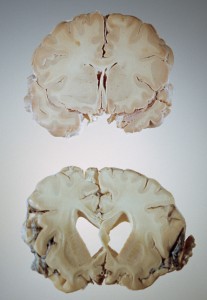
Differences in a healthy brain (top) and a diseased one (bottom) clearly show the damage wrought by Alzheimer’s. Credit: © Maggie Steber/National Geographic Society, Corbis
The polite term for what Alzheimer’s disease does to the brain is “neurodegeneration.”
In reality, it’s more like violent, indiscriminate devastation. Alzheimer’s scrambles communication channels, incites massive inflammation and demolishes entire brain regions as once plump cells shrivel and die, burying memories in the wreckage. As the attack intensifies, Alzheimer’s gradually strips away a person’s mind, and ultimately the cognitive abilities that permit a conversation with a loved one, a smile or a taste of food.
A couple of decades ago, some researchers thought they knew the root cause of this brain invasion?—?dangerous buildups of a protein called amyloid-beta. Get rid of these big, sticky globs and cure the disease, the reasoning went. But in recent years, a deeper understanding of the disease, along with a few disappointing clinical trials, has challenged long-held assumptions and forced a reevaluation of this strategy.
Many researchers are convinced that A-beta is still a key target. A litany of damning evidence from genetics, pathology reports and lab experiments makes that case. Yet recent results show that A-beta is not the same foe it was originally thought to be. Smaller pieces of A-beta?—?not the large plaques that were formerly indicted?—?are likely to be malicious, capable of destroying nerve cell connections, several new studies show. Other data coming from sophisticated imaging techniques may illuminate how, when and where A-beta accumulates in the brain, and how this buildup might relate to diminished mental powers.
Yet the fact that A-beta can also accumulate in healthy brains, among other findings, has caused some Alzheimer’s researchers to shift their sights away from that protein. A new model proposes that inflammation, along with the harmful marinade it brings, might be a central cause of the disease. Other studies are turning up links between Alzheimer’s and the curious tendency of brain cells under stress to double their genetic material.
As the baby boomers age, the number of elderly Americans with Alzheimer’s is projected to reach 13.5 million by 2050. Assuming no breakthroughs in treatment, health care costs will continue to increase as well. Alzheimer’s Association
While the cause of Alzheimer’s remains elusive, the extent of its threat to the brain is becoming increasingly clear. Each week, new studies chronicle the damage in ever more detail: Chemicals that carry messages between nerve cells go MIA, brain cells’ birthrates plummet, cells’ energy output goes haywire, cell waste begins to pile up and harmful reactive chemicals get produced. Ultimately, brain cells die.Teasing apart this tangled web – in which it’s nearly impossible to distinguish a diabolical mastermind from a lowly hired gun or even an innocent bystander?—?isn’t easy. If it were, the problem would be solved by now. “I think we have to be honest and say this is an incredibly complicated condition, and it’s going to be very hard to tackle it,” says Alzheimer’s researcher Lennart Mucke of the University of California, San Francisco.
